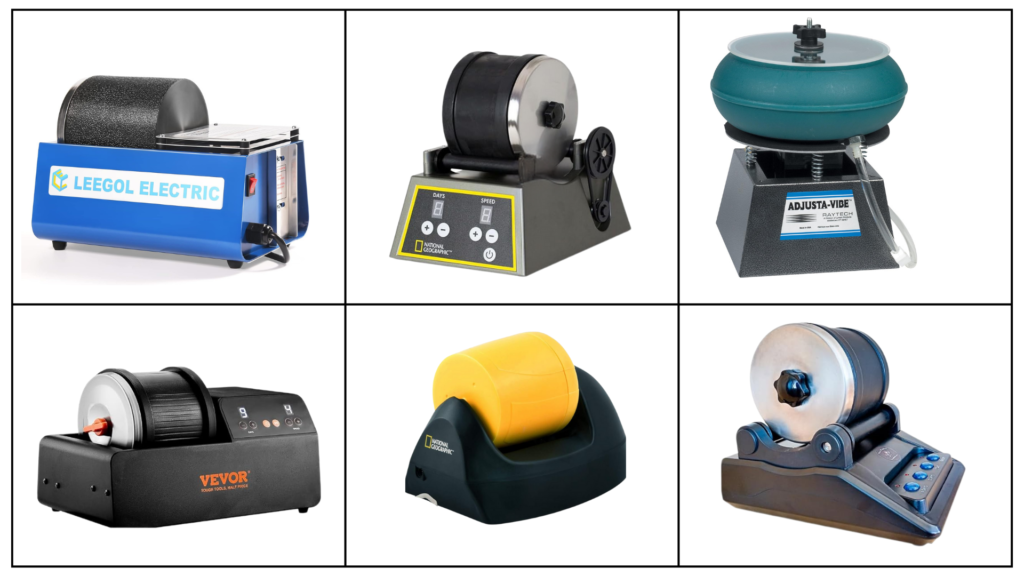Rock tumbling is an enjoyable and rewarding hobby that can transform rough stones into polished gems. However, choosing the right rock tumbler can be daunting for beginners due to the variety of options available. This guide will walk you through the key factors to consider when selecting your first rock tumbler.
1. Understanding the Types of Rock Tumblers
There are two main types of rock tumblers: rotary tumblers and vibratory tumblers. Each has its own advantages and best uses.
Rotary Tumblers
Rotary tumblers are the most common choice for beginners. They have a rotating barrel that grinds and polishes the rocks over several weeks. Rotary tumblers are ideal for shaping and smoothing rocks.
Pros:
- Affordable and widely available
- Easy to use
- Great for rounding and smoothing rocks
Cons:
- Slower process (can take several weeks)
- May require more grit
Vibratory Tumblers
Vibratory tumblers use vibration instead of rotation to polish the rocks. They work faster than rotary tumblers and are often used for the final polishing stages.
Pros:
- Faster polishing time
- Uses less grit
- Better for delicate stones
Cons:
- Generally more expensive
- Not as effective for initial shaping
2. Barrel Size
The size of the tumbler barrel is an important consideration. Barrels come in various sizes, typically ranging from 1.5 pounds to 15 pounds or more. For beginners, a smaller barrel (3 to 6 pounds) is usually sufficient.
Considerations:
- Smaller barrels (1.5–3 lbs): Ideal for small batches and hobbyists with limited space.
- Medium barrels (3–6 lbs): Suitable for most beginners and offers a good balance between capacity and convenience.
- Larger barrels (6+ lbs): Best for more serious rock tumblers who want to process larger quantities.
3. Material Quality
The material of the tumbler barrel affects durability and performance. Barrels are commonly made from rubber or plastic.
- Rubber barrels: Quieter operation, more durable, and less likely to leak.
- Plastic barrels: Lighter and usually cheaper, but may be noisier and less durable.
4. Budget
Your budget is a critical factor when choosing a rock tumbler. Prices can range from around $50 for basic models to several hundred dollars for high-end units. Here are some general price ranges:
- Entry-level tumblers ($50–$100): Basic features, suitable for beginners and light use.
- Mid-range tumblers ($100–$200): Better build quality and larger capacity, ideal for serious hobbyists.
- High-end tumblers ($200+): Professional-grade machines with advanced features and larger capacities.
5. Brand Reputation
Researching the reputation of different brands can help ensure you get a reliable and efficient rock tumbler. Some well-known brands include:
- Lortone: Known for their high-quality rotary tumblers.
- Thumler’s Tumblers: Offers a wide range of both rotary and vibratory tumblers.
- National Geographic: Provides beginner-friendly kits that are perfect for kids and newcomers.
6. Additional Features
Some rock tumblers come with additional features that can enhance your experience:
- Timer: Allows you to set and forget, automatically turning off the machine after a set period.
- Speed settings: Adjustable speeds can offer more control over the tumbling process.
- Starter kits: Includes everything you need to start, such as grit, rocks, and instructions.
Conclusion
Choosing the right rock tumbler involves considering your specific needs, budget, and the type of rocks you plan to polish. By understanding the different types of tumblers, barrel sizes, materials, and features, you can make an informed decision and embark on a successful rock tumbling journey. Happy tumbling!


